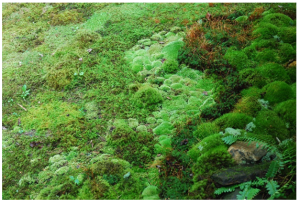Sunday, July 25, 1915
Divisional Reserve
The Battalion War Diarist wrote nothing for this day. [1]
THIS DAY IN RMR HISTORY: Sphagnum moss gathered from the peat bogs in the English Peak District in the north and on Dartmoor in the south-west helped saved the lives of wounded men returning from the trenches in World War One.

“The moss is now used mostly for hanging baskets because it’s so absorbent but it also has antiseptic qualities which made it a great substitute for cotton in thick bandages. The war took place before the discovery of penicillin, so its ability to both staunch open wounds and inhibit bacterial growth made it indispensable. It would be shaken out, to remove debris and even dead frogs, squeezed to reduce the moisture and laid out on dust sheets to dry in the sun. It was sewn into muslin bags and reduced the need to change dressings so often; saving time for busy nurses, lessening distress to patients and reducing laundry costs.”
The article below from The Times of London, tells of steps taken to process the moss gathered to produce Field Dressings:
“Quiet but busy men and women are doing good things in the heart of Dartmoor. For Princetown is the headquarters of the sphagnum moss work in the West, and from this grey village, 1,500 feet above the sea, among the tors, there weekly depart to the Midlands, to the West and South, and overseas, a hundred sacks of dried moss and 500 prepared dressings, ready for immediate hospital service.
Often knee-deep in the great bogs and mires for miles round a man, who has devoted himself to the work, labours daily in the fair and foul weather. Nearly 5,000 sacks has this devoted worker collected since last spring, and his masses of material come from the moor up to an asphalt lawn-tennis court at Princetown, where the officers of the convict prisons took recreation in pre-war times. Here men and women spread and turn the masses of the moss day by day, and their difficulties are great in wet weeks, for sphagnum is the most absorbent of vegetable things, and this surgical virtue means that one storm of rain will waste a week of sunshine. But it reaches a good measure of dryness at last, and is then carried to the depot – a house of many rooms hard by, taken for the purpose, sweet with whitewash and antiseptics, heated by hot air from a furnace, and full of women clad and capped in spotless white.
The moss has shed its lustre now, the ivory and green and gold have faded, and it is reduced to the colour of hay. Here it is spread on a grille above a system of hot-water- pipes, and rendered until crisp and springy. Thus perfected, it is dispatched to the hospitals for further treatment; but the depot is not content with being the largest centre for distribution in England; dressings are also made, and the laborious treatment of the moss followed in every particular until the finished dressings have been completed. Three hours careful work go to each. The moss is first picked over, and every shred passes through a woman’s fingers, to remove grass and twigs and the thousand fragments from the heath buried in its soft masses. The pure stuff is now ready for the dressings, and two ounces of moss go to each little, flat muslin bag, 10 inches by 14. They are then passed through a solution of corrosive sublimate (a refining or purifying substance) by a worker in rubber gloves, squeezed through a little mangle, and dried again, that they may return to the specified weight, for after the bath they are two ounces too heavy. Now, perfected, the dressings are made into packets of a dozen each, and wrapped in two papers; finally, for overseas, they are packed into bales of a hundred dressings covered with waterproof sheeting through which no germ can penetrate. Thus they depart by the thousand, and the cry is still for more. Every facility is here, and, thanks to the Prince of Wales, all things necessary for the work have been found. The workers only are lacking, and if a few shell-shocked soldiers or other willing hands could be found to assist the present overworked and too scanty staff of volunteers, much would be gained. Let active, elderly men who sigh for an opportunity to serve, come to Princetown. Before November a harvest must be garnered sufficient to meet potential needs until the spring – a task only certain of accomplishment given sufficient aid. Half a dozen men capable of daily, easy work would end the anxieties of the present staff and ensure the vital needs of the Red Cross until another spring.
In addition to extraordinary absorbent qualities – a two ounce dressing will absorb up to two pounds – sphagnum has its own antiseptic virtues. It contains iodine, and has been proved of the utmost hospital value, answering every test.” [3]
[1] War Diary, 14th Canadian Battalion, The Royal Montreal Regiment, July 25, 1915. Library and Archives Canada, Ottawa http://data2.collectionscanada.ca/e/e044/e001089764.jpg
[2] “World War One At Home - Longshaw, Derbyshire: Sphagnum Moss For Wounds”, The BBC, July 30, 2014, http://www.bbc.co.uk/programmes/p0230n3t
[3] The Times, London, Tuesday, September 03, 1918; Issue 41885; pg. 9, col. E as found at : http://www.legendarydartmoor.co.uk/moss_gatherers.htm

